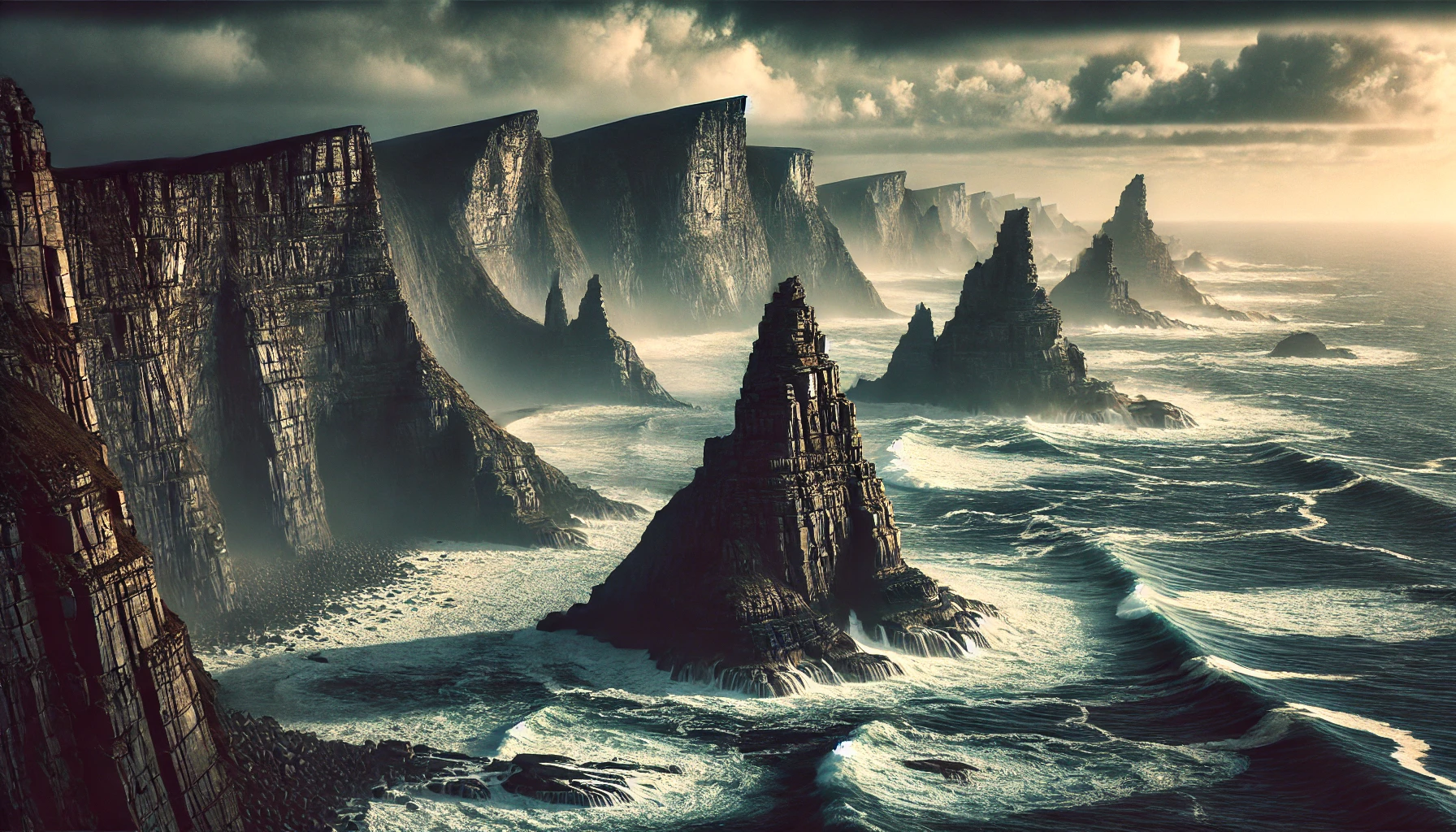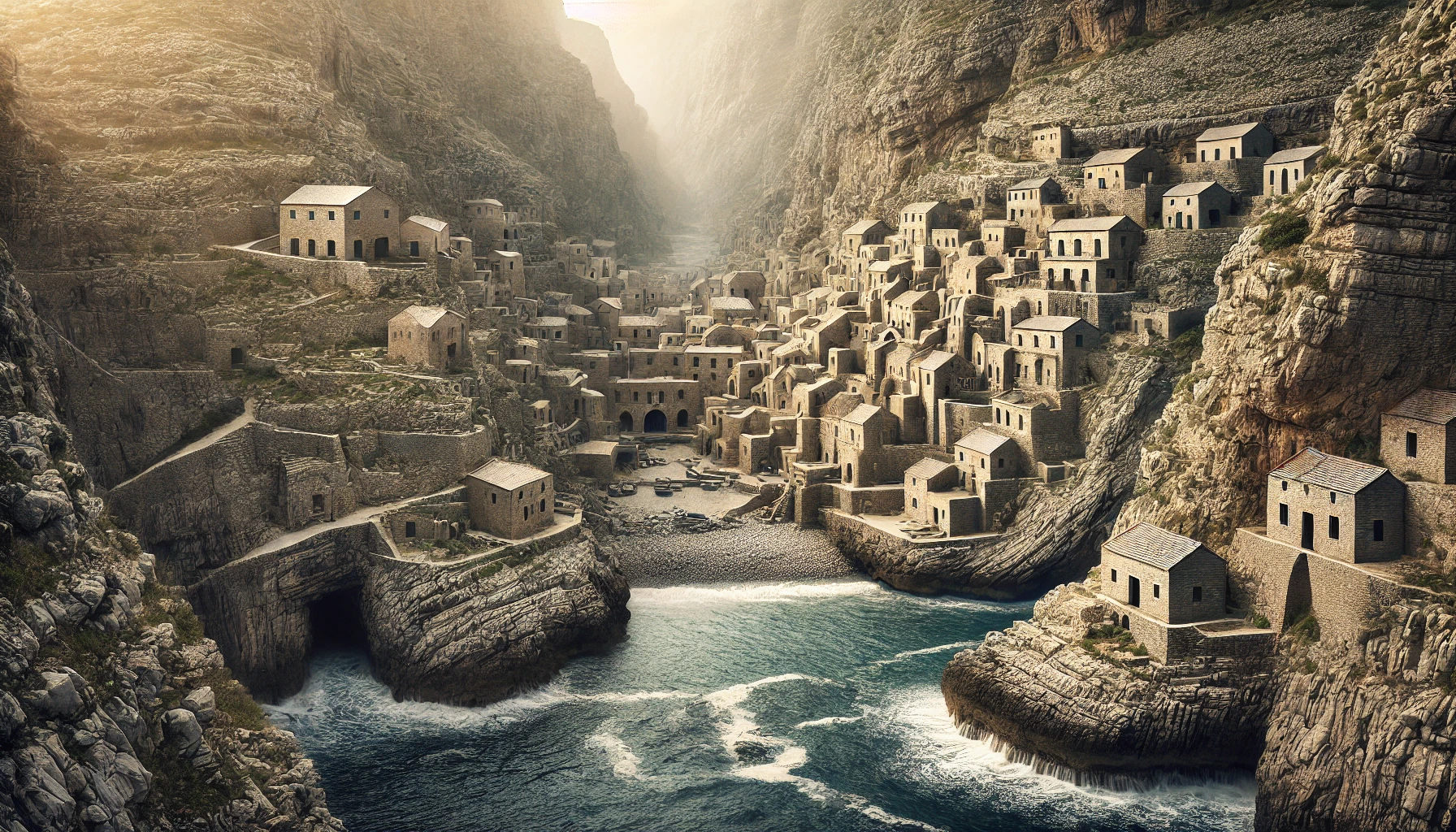[ay-gear coast]
1. Overview
On the North-Eastern edge of Siar’Morrin is the Aegir Coast, a rugged and breathtaking region, known for its dramatic cliffs and the relentless pounding of the ocean waves. The Aegir Coast is a place of raw power and untamed beauty. Here, the sea carves the land with both fury and artistry, shaping a coastline that is both a challenge and a spectacle. Despite the harsh and unforgiving nature of the coastline, several cities have taken root along its shores, their inhabitants creating a life amidst the tumult of the ocean, relying on the bounty of the sea for sustenance and trade.

2. Geography
The geography of the Aegir Coast is defined by its sheer cliffs that rise dramatically from the churning ocean below, and its towering promontories that stretch defiantly into the sea. The relentless tides and fierce storms have sculpted this landscape over centuries, creating a series of rugged headlands and secluded coves. The tumultuous interaction between land and sea is a constant here, making the coastline a dynamic and ever-changing boundary where nature displays its most forceful elements.
3. History
Historically, the Aegir Coast was a beacon of scientific and technological enlightenment, where advancements in magic and numerous other disciplines were made at remarkable rates. It was known for its vibrant academic communities that pursued a wide array of innovations, from exploring the depths of the ocean to unlocking the mysteries of arcane energies. This pursuit of knowledge made the coast a hub of intellectual activity and discovery, drawing scholars and inventors from across the realm.
However, the Age of Darkness (AoD) marked a profound shift in the region. The catastrophic events brought about by this period led to a significant loss of scientific knowledge and technological capability. The communities along the Aegir Coast were forced to abandon their pursuit of advancement and revert to simpler, more survival-focused ways of living. This transition saw a dramatic shift from a society once at the forefront of civilization’s progress to one deeply rooted in basic, day-to-day survival strategies
4. Political Structure
The political organization of the Aegir Coast operates under a collaborative framework known as the Transitional Governance Council (TGC), established to manage and unify the various city-states along the coastline. This council was formed in response to the increasing need for a coordinated approach to regional challenges, particularly those posed by the unpredictable marine environment and external threats.
The TGC is composed of elected representatives from each of the coastal city-states, ensuring that each locality has a voice in regional affairs. The council’s primary mandate is to develop and implement policies that standardize economic practices and defensive strategies across the coast. One of the main challenges facing the TGC is balancing the strong sense of local autonomy cherished by individual city-states with the need for regional cohesion. Many of these cities have a long history of independence and are wary of yielding too much power to a centralized authority. This tension is often visible in council debates, where the push and pull between local interests and collective needs can lead to protracted negotiations and, occasionally, gridlock.
5. Economy
The Aegir Coast’s economy is fundamentally anchored in maritime activities, predominantly fishing and trade. The turbulent seas provide a rich bounty of fish and other marine resources, which constitute the primary livelihood for the coastal cities. Despite a historic focus on technological innovation and scientific discovery, the Age of Mortals has seen these sectors decline, with traditional industries taking precedence once more. Trade primarily occurs with nearby regions, and the economic health of the coast heavily depends on these relationships, sometimes strained by competitive interests.
6. Culture and Society
The Aegir Coast is a region defined by its rugged natural environment and the resilient character of its people. Residents of the coast are known for their stoicism and fortitude, traits honed by generations living in close communion with the sea’s capricious moods. The harsh coastal climate and the demanding daily interaction with the ocean have shaped a community that values strength, resilience, and a deep respect for the natural world.
Religiously, the people of the Aegir Coast hold a complex set of beliefs centered around oceanic deities. Ooscie, known as the Ocean Father, is revered as a protector and provider, integral to their way of life. The coastal inhabitants regularly conduct rituals and offer sacrifices to appease Ooscie and his sons, seeking their blessing for safe voyages and abundant catches. However, his forsaken daughter, Ooscara, is viewed with fear and disdain. Known as the bringer of winter and relentless winds, worshiping Ooscara is considered taboo, believed to invite disaster and bad luck upon oneself and one’s community. This has lead to poor relations with the glacimancer of the Arctic Expanse, with travelers from this region often finding themselves barred access to many of the cities within this region.
While the people of the Aegir Coast share a common reverence for the sea, their society is marked by a rugged individualism that celebrates personal achievements and resilience. This has led to a culture that prizes tales of survival and bravery, often passed down through generations in the form of stories and songs. Despite the harsh conditions, there is a vibrant cultural scene that thrives on crafts, music, and art, much of it inspired by the sea and the tales of those who navigate its waters.
7. Military
The military capabilities of the Aegir Coast are uniquely adapted to the demands of its rugged terrain and the maritime nature of its threats. Lacking a centralized standing army, the region relies instead on a coalition of local militias provided by the city-states along the coast. These militias are primarily composed of citizen-soldiers, individuals who spend part of their year engaged in civilian occupations, such as fishing or trade, and part in active military service.
Each city-state along the Aegir Coast maintains its own militia, trained to defend against the specific challenges faced by their local area. This could include repelling pirate raids, which are frequent given the region’s rich maritime routes, or defending against the occasional incursion by sea monsters that are drawn closer to shore by stormy weather.
Coordination among these disparate forces is managed by the Transitional Governance Council, which has taken on the role of organizing collective defense strategies. Despite their primarily defensive posture, the militias of the Aegir Coast are remarkably effective. Their deep familiarity with the local environment gives them an advantage in navigating the challenging coastal waters and rocky terrain.
8. Notable Locations
- Cragport: The primary port city of the Aegir Coast, Cragport is built on a series of steep cliffs that plunge dramatically into the sea. Known for its rugged architecture and resilient population, Cragport serves as a major hub for fishing and trade, with a natural harbor protected by towering rock formations.
- Stormwatch Keep: Perched atop the highest promontory on the coast, Stormwatch Keep is a historic fortress that has been converted into a lookout and signaling station. It plays a crucial role in monitoring sea conditions and warning of incoming storms or pirate raids, making it a key defensive point for the entire region.
- Tideholm: An isolated island off the coast, Tideholm is famed for its ancient monastery that dates back to a bygone era. The monastery is partially in ruins but remains a place of pilgrimage and solitude, where some of the coast’s oldest manuscripts and relics are preserved.
- The Wreckers’ Bay: A notorious stretch of coastline littered with shipwrecks, the result of treacherous currents and deceptive reefs. Local lore is rich with tales of wreckers who once lured ships to their doom to plunder their cargoes.
- Gale’s End: The northernmost village on the Aegir Coast, known for its extreme weather conditions and the hardy nature of its inhabitants. Gale’s End is often the first line of defense against threats coming from the pirates of Nordholt.
- Ocean’s Gate: The southern most city in the Aegir Coast, Ocean’s Gate is built within a narrow gulf flanked by sharp cliffs. The entrance to this gulf is marked by a pair of massive, ancient stone columns, said to have been placed by the legendary Ocean Father, Ooscie.
- Asteri Cave: Nestled within the rugged cliffs of the Aegir Coast, Asteri Cave is renowned for its breathtaking beauty. The interior of the cave is a natural marvel, with a ceiling that glitters like a starlit sky. Despite its allure, the cave is shrouded in mystery and entrance forbidden.

9. Significant Characters
- Lyara “Wave-Singer” Corven: Council representative of Cragport, Lyara is a sorceress of formidable renown whose mastery over water magic has safeguarded Cragport for decades. Though her body has grown frail with age, her presence in council chambers carries immense weight.
- Marlin Tideholm: Warden of Stormwatch, a seasoned sailor turned watch commander, Marlin oversees Stormwatch Keep and its critical role in monitoring the coastline for storms and raiders. Known for his stern discipline and almost uncanny ability to “smell” a storm before it forms.
- High Abbess Serina: The spiritual leader of the monastery on Tideholm, Abbess Serina is revered for her wisdom and dedication to preserving the fragments of knowledge lost in the Age of Darkness.
- Elrik Wrecker: A controversial figure, Elrik is both a folk hero and a villain, depending on whom you ask. Born into a family with ties to the wreckers of old, he has embraced his ancestors’ reputation while reshaping it—he uses his mastery of treacherous waters to guide ships safely through, but demands steep fees in return.
10. Current Issues and Future Prospects
The Aegir Coast faces ongoing challenges from environmental threats, such as crumbling cliffsides and increased storm activity, which threaten its cities and economic stability. Politically, the effort to unify the governance structure is an ongoing struggle against deeply entrenched local autonomy. Future prospects include potential development of sustainable maritime technologies to revive the region’s historical strengths in innovation, aiming to blend traditional knowledge with new advancements to secure a prosperous future for the Aegir Coast.